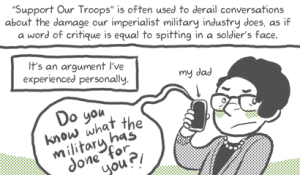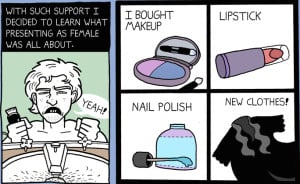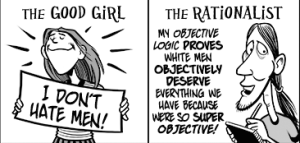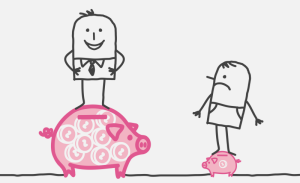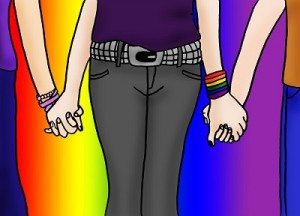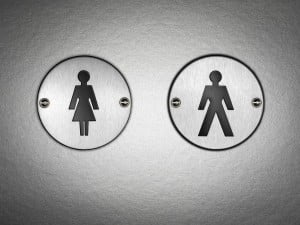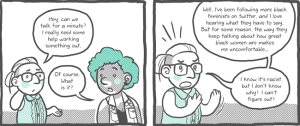JOHN QUIÑONES: This woman is shopping in an upscale New York City boutique.
SALES CLERK: It’s actually more of an upscale store. I’m not sure if you’ll find anything that you’re looking for.
JOHN: She is looking for a new outfit, but the store’s employees are on the lookout for people like her.
CLERK: I don’t need you any further in the store because I can’t keep my eye on you.
People like you come in and they take things and they start—
WOMAN: People like me?
CLERK: I think you know what I’m talking about. I don’t feel comfortable with you in the store.
JOHN: Keep your eye on these two women.
CLERK: I’m not sure you can actually afford something like this. Let me fold this back.
JOHN: The more offensive the sales clerk is…
CLERK: Ma’am, people like you, they can’t afford stuff like this.
JOHN: …the more they keep their attention on the merchandise. We catch up with the two women outside.
CUSTOMER 1: I did actually feel sorry for the girl.
JOHN: Will you do something next time?
CUSTOMER 2: I wouldn’t have got involved, no — because it’s nothing to do with me.
JOHN: But she needed your help. Someone has to sound the alarm.
CUSTOMER 2: But I don’t know her.
JOHN: The two customers have just witnessed a type of discrimination so common that researchers have given it a name: shopping while black. In a recent survey, 60% of African Americans say they have experienced it, and sadly, it has all the makings of a perfect What Would You Do? experiment.
In our scenario, actors portrayed a store clerk, a security guard, and a shopper who we dressed up and down. She is the target of the abuse. We wanted to see if any of the other shoppers will do anything at all.
Our base of operation is in one of the shopping capitals of the world, Soho in New York. And we find practically the only store willing to experiment with something so controversial, a woman’s boutique called Unpomela.
CLERK: People like you come in and then just slip things in your bag. You’ve got a big jacket and everything.
WOMAN: What does “people like you” mean?
CLERK: I think you know what I’m talking about.
WOMAN: I don’t.
CLERK: If you need to, shop in Harlem. Go shop in Harlem. You’re not shopping in our store.
JOHN: Inside the store, the harassment continues.
SECURITY: Put your arms out, please. It’s not the first time, I’m sure. You know what I’m talking about.
WOMAN: Excuse me. I’m being searched and I’m just a shopper. Did this happen to you?
JOHN: No response here. And just seconds later, she’s back to primping.
WOMAN: What is your name? Are you the manager?
CLERK: Yes. I’m just doing my job.
WOMAN: You’re doing a horrible job. Okay? You treat me like I’m a criminal.
JOHN: Watch this couple. They’ve been browsing right next to our actors.
SECURITY: You’re really disturbing them.
WOMAN: They should know that they shop in a place where paying customers get frisked. I’m the only black woman in here.
SECURITY: Right.
WOMAN: And I’m the only person this is happening to.
SECURITY: Exactly.
WOMAN: Do you see?
JOHN: Our security guard tries to draw the couple in.
SECURITY: I don’t go to your neighborhood when I’m shopping.
WOMAN: You don’t go to my neighborhood?
SECURITY: Yes.
WOMAN: You don’t even know where I live.
SECURITY: Sorry, guys.
CLERK: I’m so sorry.
MAN: That’s all right.
CLERK: Did y’all need help looking for clothes or anything?
MAN: We’re just looking for something that she might like.
JOHN: But not a word in a defense of our shopper. And we couldn’t believe what happened next.
CLERK: Have you guys ever experienced something like that? It’s just crazy.
MAN: What’s that?
CLERK: Someone like her coming in and—I mean, she looks very suspicious. I had two ladies like that come in last week. It just looks like they’re going to do something. You know?
MAN: She probably played the black card, right?
JOHN: What did he just say?
CLERK: You know?
MAN: She probably played the black card, right?
CLERK: Yeah. I guess it just seems like it’s more black people than it is than others.
JOHN: We’re doing an experiment on racial profiling.
MAN: Uh-oh.
JOHN: And it was all a scenario we staged called What Would You Do?
MAN: Oh. I felt so bad for her.
JOHN: Suddenly, it seems he changes his tune.
MAN: Oh. I felt so bad for her.
JOHN: Well, she’s okay, but it could’ve been real. Do you feel it was your role to step in and defend her at all?
MAN: Would you have defended me?
JOHN: Yes.
Meanwhile, back inside the store…
WOMAN: Why do I have to leave? I didn’t do anything wrong.
SECURITY: This is preventative. Loss prevention.
WOMAN: You’re throwing me out of the store because I’m black.
JOHN: Notice this customer is having a hard time concentrating on the merchandise. A few minutes later, and just as we did the man before her, we instruct our sales clerk to engage her.
CLERK: I think it’s probably more of appearance than just that kind of people. The probability is just higher.
CUSTOMER 3: What does that mean, the type of people? I don’t understand.
CLERK: The statistics are like higher for people of—
CUSTOMER 3: Of what?
CLERK: … different types.
CUSTOMER 3: “Type.” You see, that’s the problem. “That type.” I’m afraid of what you’re going to say when you clarify what “type” means.
CLERK: Yeah.
CUSTOMER 3: That’s really disturbing to me.
CLERK: But it’s the facts, and I think it’s just—
CUSTOMER 3: Oh my goodness. You are saying what I think you’re saying. I wish she would just stop asking me about this and talking to me.
JOHN: She’s so upset, she begins to cry. It’s time to introduce myself.
Hi. I’m John. I’m John Quiñones.
CUSTOMER 3: Hi.
JOHN: I’m a reporter with ABC. Do you know this is part of the experiment, right?
CUSTOMER 3: I was just told that.
JOHN: We didn’t want you to be that upset. We did want to find out how people would react, and what should they do, and what should they say because this exists. You know? Racism does exist.
CUSTOMER 3: I’m so glad that this is not real.
WOMAN: Thank you.
CLERK: Ma’am, your type comes in here a lot and I just need to make sure—
WOMAN: My type?
CLERK: Yes.
JOHN: This man and his family have a front row seat.
MAN 2: What’s her type?
That’s not good.
CLERK: No, sir—
MAN 2: That’s not good.
CLERK: I’ve had trouble with—
MAN 2: I’m sitting here, and I’m a good guy.
JOHN: Maybe they’ve heard a little too much.
CLERK: You’re upscale, she’s not—
MAN 2: Do you know how embarrassing it is to do this to her?
CLERK: No.
MAN 2: Why are you singling her out like that?
CLERK: Because look at her.
MAN 2: Look at her? What?
CLERK: I’ve tried to—
MAN 2: Let’s go. Let’s go, babies. Let’s go.
CLERK: …protect this store.
JOHN: Stunned by the insults, he tries to leave, but our sales clerk won’t let him go.
CLERK: We had this happen last week and I need to make sure that it doesn’t happen. It comes out of my pocket.
MAN 2: Listen, I’m not stating that you shouldn’t do your job, but the way you’re doing your job isn’t right.
CLERK: So how would I do it?
MAN 2: You don’t need to be working here if you don’t know how you would do it.
JOHN: He’s finally had enough.
MAN 2: But you should apologize. That’s cold. That’s sick. That’s sick.
JOHN: Excuse me, sir. Hi. I’m John Quiñones with ABC.
MAN 2: Man, I can’t talk right now.
JOHN: I know you’re upset. Do you know what this was? It’s an experiment on racism, and a lot of people didn’t say a thing, and it’s a wonderful thing you did.
MAN 2: I usually don’t say anything, but I couldn’t sit there because it wasn’t security after a certain point.
WOMAN: You came to my rescue. No, seriously. It’s so humiliating. It’s embarrassing, you know? I’ve been followed around in stores before. I have to be conscious of the way I dress before I go shopping.
JOHN: Almost 100 people witness our scenario, and less than 20 intervene. It was clear from our experiment that people of color feel the most strongly. But we were surprised by some of the other folks who decided to step in.
CLERK: I just don’t feel comfortable right now with you in the store. I’m sorry, and I can’t subject them to this.
CUSTOMER 4: I think you should put in a complaint. Sorry. As somebody who is shopping, you’ve done nothing wrong.
CLERK: I’ve had people like her come in and this is what happens. I need you to frisk her, please.
CUSTOMER 4: She’s done nothing. I’m dressed more casually than she is.
WOMAN: I have not done anything wrong.
SECURITY: Turn around. Turn around.
WOMAN: I’m coming to your store as a customer.
JOHN: Our security guard ignores the woman’s pleas and fools them.
SECURITY: Put your arms out.
CUSTOMER 4: Sorry. I’ll walk out with you.
JOHN: And just like that, the two women decide to leave the store and take our shopper with them. And an entourage of angry customers follows.
MAN 3: She’s being completely humiliated by this woman.
JOHN: Outside, the crowd is so caught up in the moment, they begin talking to our camera crew, not realizing they’re part of our show. What should people do?
CUSTOMER 4: Well, I think she should put in a complaint for one thing.
JOHN: I have a confession to make.
CUSTOMER 4: What’s that?
JOHN: This is all part of an experiment on racism. She’s an actress and she’s an actress inside. But it’s a great store. The owner is Jimmy.
JIMMY: Hi, guys. I’m so sorry, but I’m so happy you guys stood up.
CUSTOMER 4: Can I try my clothes on now?
JIMMY: Yes, of course. Please come back inside.





